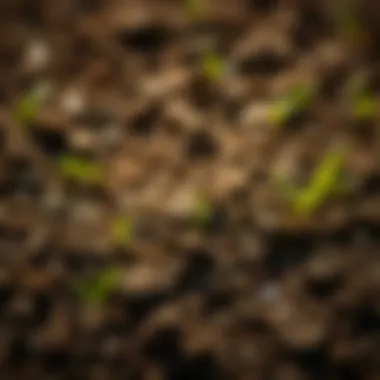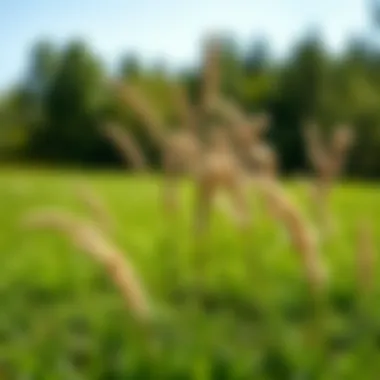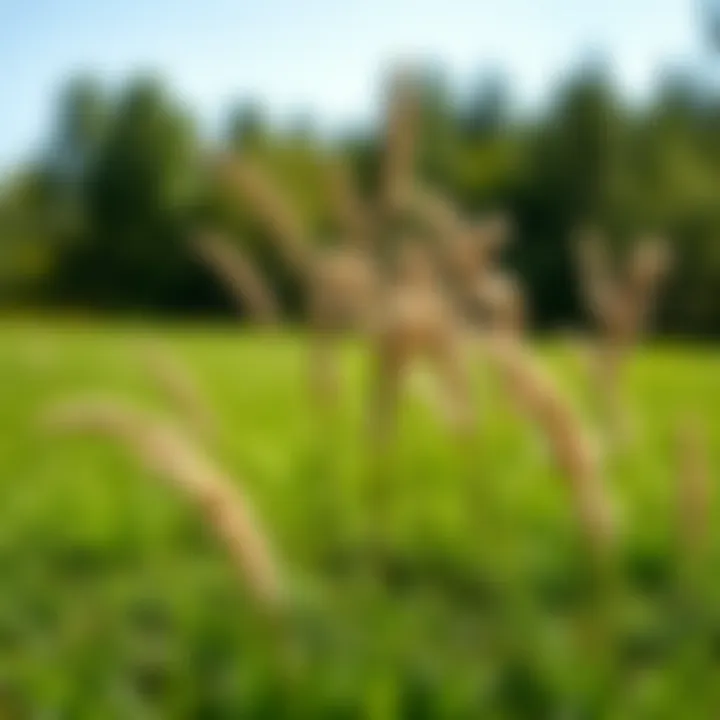Optimal Timing for Patch Seeding Your Lawn


Intro
Achieving a lush lawn isn't merely a matter of whim or chance; it requires a good understanding of nature's rhythm. Enter patch seeding, a valuable technique for revitalizing thin or sparse areas in your yard. But when is the right time to undertake this endeavor? Fertile ground lies in recognizing that timing can make or break your efforts. Wanting a vibrant lawn isn't universal; it involves understanding seasonal shifts, soil conditions, and the specific traits of the grass varieties you're planting. This is not just about throwing seeds on the ground and hoping for the best.
Topic Overview
Definition and Importance
Patch seeding refers to the process of sowing seeds in bare spots or thinning areas of the lawn to improve overall health and appearance. Think of it as patching up a worn-out garment. It’s crucial because a dense lawn doesn’t merely look good; it prevents soil erosion, promotes biodiversity, and helps in water retention—elements essential for a sustainable ecosystem. A well-maintained lawn does wonders not only for the home aesthetic but also for the environment, serving as a natural air purifier.
Brief History and Evolution
Historically, lawn care goes back centuries, with evidence of early grass plantings dating to ancient Mesopotamia. However, patch seeding as a specific practice has evolved. Early on, sowing was done haphazardly, often losing seeds to the elements. But as techniques advanced, scientists began to understand the specific needs of different grass types, leading to more targeted patching methods. This development wasn’t just about aesthetics; it became a subject of economic significance as well, as a healthy lawn contributes to property values.
Key Techniques and Innovations
Sustainable Farming Practices
In today's world, sustainable practices are no longer just buzzwords. Utilizing native grasses for patch seeding is not only beneficial for the local environment but often requires less water and maintenance. Consider using compost in your soil preparation or opting for organic fertilizers to minimize environmental impact. The goal should be to fit your patch seeding efforts within the larger context of ecological balance.
Advanced Agronomic Technologies
Technology has transformed how we approach patch seeding. Soil testing kits can provide you with essential insights into nutrient levels, pH balance, and moisture content—elements that fundamentally impact seed germination and growth. Similarly, software and apps can offer personalized recommendations for optimal timing, ensuring you're not shooting in the dark.
Practical Applications
Step-by-Step Guides
- Assessment: Start by evaluating your lawn's condition to identify sparse areas.
- Soil Preparation: Test your soil and loosen it. Ensure the pH is conducive to the grass type you plan to sow.
- Seed Selection: Choose a grass variety that suits your climate and existing lawn species.
- Aeration: Consider aerating the soil before seeding. This encourages seed and moisture interaction.
- Seeding: Disperse seeds evenly, ensuring good coverage.
- Watering: Employ a light watering regime post-seeding, keeping the soil moist but not soggy.
- Post-Care: Follow up with fertilizers as needed, and know when to mow to let the new grass flourish.
Case Studies or Real-World Examples
A homeowner in Ohio noticed patches in the front yard due to heavy foot traffic. Instead of re-laying sod, they decided to patch seed using a mix of Kentucky Bluegrass and fescue. By seeding just before the fall, their lawn thickened considerably over the winter months, showing vibrant growth come spring. This success underscores the significance of timing and understanding the grasses chosen.
"Every blade of grass has its time to rise and fulfill its role in the ecosystem. Knowing when to plant is like knowing the secret handshake of the garden."
This journey through patch seeding emphasizes the integration of knowledge and technique. Whether you’re a novice gardener or someone well-versed in lawn care, understanding optimal timing and conditions can pave the way for a thriving, sustainable lawn. For further reading, check out resources like Wikipedia or Britannica.
Understanding Patch Seeding
Patch seeding is not just a fancy term tossed around by gardening enthusiasts; it is a vital strategy for maintaining a healthy lawn. A bare patch of grass can be a sore sight and may even stir up embarrassment when hosting backyard gatherings. So, understanding the ins and outs of patch seeding is essential, whether you are a novice gardener or a seasoned pro. This section unpacks the fundamental aspects of patch seeding, its significance, and the benefits it brings to your lawn care routine.
Definition of Patch Seeding
Patch seeding is the method of applying grass seed to specific areas of your lawn that are thin, dead, or damaged. You might find this technique useful for reviving areas affected by heavy foot traffic, pet activity, or irritable weather conditions. The process typically involves preparing the soil, sowing grass seed, and ensuring the seeds are cared for until they germinate. Unlike complete overseeding, which covers the entire expanse, patch seeding is more targeted and focuses on repairing issues, making it a more economical and practical approach in many cases.
Importance of Healthy Lawn
A healthy lawn is more than just aesthetically pleasing. It plays a critical role in environmental sustainability. Grasses absorb carbon dioxide and convert it to oxygen, providing cleaner air for all living things. Moreover, a robust turf acts as a natural filter for rainwater, reducing runoff and minimizing soil erosion.
When you invest time in patch seeding, you aren't merely fixing pesky bare spots; you're enriching your entire ecosystem. Each little patch has the potential to contribute to a larger purpose—the health of your yard.
Moreover, a well-maintained lawn can deter pests, reducing the need for harmful chemicals. Healthy grass creates a natural habitat for beneficial insects, transforming your yard into a microcosm of ecological balance. As such, knowing when and how to patch seed is not just an exercise in improving your curb appeal; it's a step toward fostering biodiversity in your own backyard.
Seasonal Considerations
Timing can make or break your patch seeding efforts. Understanding the seasons is crucial for everyone from the seasoned gardener to the enthusiastic beginner. Each season brings unique opportunities and challenges that can affect the health and growth of your lawn. Seeding at the right time helps ensure that your grass has the best chance to establish itself, flourish, and combat weeds and pests.
Spring Seeding
Spring is often considered the prime time to give your lawn a fresh start. The combination of warming temperatures and increasing daylight works wonders for grass seeds. As the snow melts and the soil begins to warm, it becomes an ideal environment for growth.
Benefits of Spring Seeding
Spring seeding provides several benefits:
- Optimal Soil Temperature: As temperatures rise, seeds can germinate quickly. Warm soil is more conducive to seed sprouting, leading to robust growth.
- Natural Rainfall: Spring usually brings adequate rain, allowing seeds to stay moist without the need for constant watering. This is pivotal for new grass to establish itself.
- Increased Sunlight: With longer days, there's more sunlight available to nourish young grass. Sunlight encourages photosynthesis, which is vital for growth.
However, the key characteristic of spring seeding that gardeners love is its potential for rapid establishment. As long as care is taken regarding weed competition and pests, spring can be a wildly successful time for patch seeding. On the flip side, if spring rains are too heavy, they may lead to erosion and wash away seeds.
Challenges in Spring


While the joys of spring seeding are plentiful, challenges exist:
- Weed Competition: Weeds can also thrive in spring, quickly competing with your new grass for nutrients and water.
- Changing Weather: Spring weather can be unpredictable. You might face late frosts or unexpected dry spells, both of which can hinder seed germination.
- Maintenance Needs: The rapid growth of both grass and weeds can call for more frequent mowing and maintenance.
Despite these challenges, the advantages often outweigh the cons, making spring a favorable time for lawn work.
Fall Seeding
As summer fades and autumn takes hold, fall becomes another key season for patch seeding. Cooler temperatures and shorter days signal to many gardeners that it’s time to rejuvenate the lawn.
Advantages of Fall Seeding
Choosing to seed in the fall can be highly advantageous:
- Ideal Growing Conditions: The cooler air temperatures paired with warm soil help grass to grow strong roots. This balance enables seeds to germinate effectively while avoiding the heat stress of summer.
- Weak Weed Competition: As temperatures drop, many weeds begin to die off, reducing competition for nutrients and water. Your new grass gets a better fighting chance.
- Moisture Retention: Fall often brings more consistent rainfall, ensuring adequate moisture for the seeds without needing extensive irrigation.
The unique feature of fall seeding is the longer establishment period you can give your grass before winter. It’s a popular choice as you can expect a more resilient lawn come spring.
Possible Risks
While fall seems like a golden opportunity, some risks are unavoidable:
- Early Frosts: Depending on your region, early frosts can complicate growth and damage young seedlings.
- Limited Daylight: Shorter days mean less sunlight for new grass. This can slow down the growth process as winter approaches.
- Variable Weather: Fall can also bring heavy rains or winds that may dislodge seeds or create uneven growth.
Balancing these risks with the benefits is key for successful fall planting.
Summer and Winter Seeding
When it comes to summer and winter, it can be tempting to seed, but these seasons come with limitations.
Limitations of Summer Seeding
Summer seeding often proves to be a gamble:
- Heat Stress: High temperatures can stress young seedlings, leading to failure in germination or diseases.
- Watering Needs: You need to stay on top of irrigation to keep the soil moist, which can be exhausting and time-consuming during hotter months.
- Pest Pressure: Increased insect activity can be a nuisance, with pests more aggressive during summer.
Next time you think about seeding in summer, consider these significant limitations and whether it would be worth the effort.
When to Avoid Winter Seeding
Seeding in winter is generally agreed upon as a no-go:
- Cold Soil Temperatures: Seeds will struggle to germinate in icy or mucky soil. Cold temperatures halt the growth process altogether.
- Snow Cover: Snow might protect seeds, but the chances of successful sprouting diminish greatly.
- Poor Survival Rates: Seeds planted right before winter may be eaten by wildlife or simply won't come to life until well into spring.
In short, while there's a time for everything in gardening, winter is typically not the right time for patch seeding.
The better you understand these seasonal nuances, the more prepared you'll be to make your lawn the talk of the town, or at least the envy of your neighbors.
Soil Preparation
Soil preparation is a crucial stepping stone in achieving a lush, thriving lawn. Before you even think about patch seeding, it’s imperative that you give your soil the attention it deserves. Healthy soil is the backbone of plant growth; it acts as a reservoir, storing essential nutrients and moisture while providing a stable foundation for new grass. Focusing on soil preparation sets you up for a successful seeding endeavor and helps ensure a robust lawn long term.
Assessing Soil Quality
The first step in the soil preparation process is assessing the quality of your soil. This involves evaluating its texture, structure, and organic matter content. Did you know that sandy soils drain quickly but may struggle to retain nutrients? Meanwhile, clay soils can be nutrient-rich but may have poor drainage, leading to waterlogged conditions. To determine your soil's quality, consider conducting a simple soil test. This test will give you insights into pH levels, nutrient content, and any potential deficiencies. Once you have this information, you can tailor your amendments effectively, ensuring your new grass has the best chance to flourish.
Soil Amendments
Types of Amendments
When talking about soil amendments, it's all about enhancing soil quality. The types can range from organic options like compost and manure to inorganic choices such as lime and gypsum. Compost, for instance, is a powerhouse amendment; it's rich in nutrients and improves the soil structure, allowing for better air circulation and drainage. On the other hand, lime is often used to adjust pH levels, making acidic soils more hospitable for grass growth. The key characteristic here is versatility. Some amendments serve dual purposes, such as promoting nutrient availability while improving soil texture. However, it’s important to note that not all amendments will be beneficial for every soil type; thus, personalized choices based on your soil test are essential.
Application Methods
How you decide to apply these amendments can make a world of difference. There are several methods, but two of the most common ones are top-dressing and tilling. Top-dressing involves spreading a thin layer of material over your existing lawn, which is ideal for improving surface quality without disturbung the entire soil profile. Tilling, on the other hand, incorporates amendments directly into the soil, and is beneficial when you're starting fresh or addressing severe soil issues. Each method has its unique features and can suit different scenarios, but over-application can lead to problems, such as nutrient runoff or soil compaction. Thus, it's wise to follow recommended guidelines for application to reap the full benefits without unnecessary drawbacks.
Aeration Techniques
Aeration is a fundamental part of preparing your soil for patch seeding. It involves perforating the soil with holes to allow air, water, and nutrients to penetrate deeper into the root zone. The benefits are substantial, especially when it comes to enhancing nutrient uptake and improving soil drainage. There are various techniques you might consider, from core aeration, which removes plugs of grass and soil, to spike aeration, where you simply poke holes into the ground. Timing and frequency of aeration should be tailored according to your local climate and lawn conditions so that you can optimize grass growth post-seeding.
In summary, preparing your soil rightly can transform your patch seeding efforts from mere attempts into flourishing success stories. With soil quality assessment, proper amendments, effective application methods, and aeration techniques, you create an ideal environment where new grass can take root and thrive.
Choosing the Right Grass Species


Choosing the right grass species is fundamental to the success of your patch seeding efforts. Different grasses thrive under varying conditions, and selecting a species that aligns with your local climate and lawn usage is essential. When you choose correctly, your lawn can flourish, becoming both a beautiful and functional space.
Types of Grass for Patch Seeding
Cool-Season Grasses
Cool-season grasses are typically best suited for regions with cold winters and warm summers. These grasses, such as Kentucky bluegrass and tall fescue, grow actively in the cooler months of spring and fall. The key characteristic of cool-season grasses is their ability to establish strong roots during these mild temperatures, making them less susceptible to heat stress. They offer a lush green appearance and a soft texture, which many homeowners find appealing.
One unique feature of cool-season grasses is their resilience against drought conditions in their growing seasons. However, they do have disadvantages; they can become dormant in the heat of summer, leading to a brown or patchy appearance. Therefore, it’s important to consider how often your lawn will be used and how much maintenance you’re willing to invest when deciding on these grass types.
Warm-Season Grasses
In contrast, warm-season grasses, which include Bermuda grass and zoysia grass, are ideal for areas that enjoy hot summers. These grasses thrive in the warmth, establishing robust growth in late spring and early summer, continuing through the hotter months. A key characteristic of warm-season grasses is their high tolerance for heat and drought, making them a popular choice for southern regions.
Their unique advantage lies in their growth habit. Warm-season grasses can create a dense, hardy lawn that withstands foot traffic, making them fantastic for families with kids or pets. Nevertheless, they can turn brown and enter dormancy in cooler seasons, which may not be visually pleasing during the winter months. Thus, understanding your local sunlight and temperature patterns is crucial before making a choice.
Local Climate Considerations
When selecting the right grass species, local climate plays a vital role. Factors such as average temperature, rainfall, and humidity can influence which grass types will establish well in your lawn. For instance, if you live in an area with prolonged dry spells, drought-resistant varieties become more appealing. Similarly, if your region experiences harsh winters, opting for cool-season grasses might be the most viable choice.
To summarize, choosing the right grass species for patch seeding involves understanding both the characteristics of the grasses themselves and the specifics of the climate where you live. Doing so lays the groundwork for a green and vibrant lawn that meets your expectations.
The Patch Seeding Process
The patch seeding process is not merely a task; it’s a pivotal journey in nurturing and reviving your lawn. This phase is fundamentally about how you approach filling in those unsightly dead or bare spots, which can detract from the overall beauty of your outdoor space. A well-executed patch seeding can rejuvenate your lawn significantly. But, understanding the methodology behind it can elevate your success rate.
Methodology Overview
There are several steps that need to be followed for effective patch seeding. First and foremost, it’s essential to have a clear plan in mind. This includes knowing the right time of year, understanding the grass types that will thrive in your area, and assessing the soil condition. You cannot simply throw seed onto the ground and hope for the best; it requires a strategic approach.
- Assess the Problem Areas: Identify where your lawn is struggling. This could be patches caused by drought, pets, or heavy foot traffic.
- Soil Preparation: If the soil isn’t right, the seeds won’t grow well. Preparing the soil by aerating it can greatly aid in germination.
- Seeding: Applying the seed evenly through one of the techniques covered later.
- Care Post Seeding: This includes watering and monitoring growth, making adjustments as necessary.
- Long-Term Maintenance: This is about maintaining the quality of your lawn once your seeded patches are growing.
The methodology for patch seeding is considered a backbone component of this process because it directly correlates to how well the seeds establish and how quickly your lawn can regain its luster.
Seeding Techniques
Understanding the two prevalent seeding techniques is essential for achieving optimal results. Each method has its own set of characteristics that makes it suitable depending on your goals and the condition of your lawn.
Broadcast Seeding
Broadcast seeding entails spreading grass seeds evenly over the lawn, often via a handheld or push spreader. This technique stands out for its simplicity and effectiveness. One key characteristic of broadcast seeding is its ability to cover large areas in a short time. It’s a popular choice among homeowners seeking to quickly restore patches of grass without delving deep into equipment and detailed processes.
Advantages:
- Efficiency: Covers large spaces quite rapidly.
- Ease of Use: Minimal equipment required—just a spreader and seeds.
- Versatility: Suitable for various grass types and soil conditions.
Disadvantages:
- Seed Waste: Without careful management, some seeds may end up where they are not needed.
- Increased Competition: Seeds may compete with existing grass, leading to uneven growth if not monitored.
Drill Seeding
Drill seeding is a more precise method that involves using a mechanized drill equipped to place seeds directly into the soil. This approach has a notable advantage, particularly in areas where the soil is compacted or grass density is critical. The drill allows for optimized placement of the seeds, ensuring they’re buried at the correct depth for germination.
Advantages:
- Precision: Ensures seeds are at the right depth, enhancing the chances of germination and establishment.
- Reduced Seed Loss: Less overall wastage compared to broadcast seeding.
- Improved Density: Better suited for improving thin patches in the lawn without interfering much with existing grass.
Disadvantages:
- Cost: It often requires renting or purchasing specialized equipment, which can be a barrier for some.
- Labor Intensive: The process can be more labor-intensive compared to broadcasting.
The chosen method will depend on specific lawn conditions and your long-term vision for your outdoor space. When done right, patch seeding paves a robust path toward a flourishing lawn, giving you a space to be proud of. After understanding the patch seeding process, it’s clear that the techniques chosen can profoundly affect growth and lawn health.
Post-Seeding Care
After you've gone through the careful process of patch seeding your lawn, the next crucial step is post-seeding care. Just as a gardener tends to a sprouting seedling, your newly seeded patches need attention to ensure they grow healthy and strong. The post-seeding period is where your efforts begin to pay off, helping to establish a vigorous lawn that can withstand challenges down the road.
Watering Regimens
When it comes to watering after seeding, every drop counts. The soil should remain consistently moist but not soggy. This balancing act can be a bit tricky but is important to help seeds germinate.


- Watering Frequency: In the initial weeks, it is advisable to water lightly and frequently—about two to three times per day. As the seeds begin to sprout, you can gradually reduce the frequency to once daily.
- Best Time to Water: Early morning is the gold standard for watering. This timing helps reduce evaporation and allows the grass to take up moisture during the cooler part of the day.
- Signs of Under-Watering: If the soil begins to dry out and your grass looks stressed or the color starts to yellow, it's time to up your watering game.
Remember: Over-watering can be just as harmful as under-watering. Keep an eye on the weather and adjust your regimen accordingly.
Applying Fertilizers
Fertilizing new grass is a bit different than treating an established lawn. Right after sowing, it is not always advisable to load your lawn with fertilizers; however, a balanced approach can help tremendously.
- Choosing the Right Fertilizer: Opt for a starter fertilizer, which is specially formulated for new grass. Look for one that’s rich in phosphorus to promote root development.
- Application Timing: Wait until the seeds have germinated and established at least a few leaves. This usually takes about 2-3 weeks after seeding. Then, you can apply the starter fertilizer as per the manufacturer instructions.
- Consider Soil Testing: If you're unsure about what fertilizer to use, it might be worth conducting a soil test. This step can provide you insights into nutrient levels and pH balance.
Mowing Techniques After Seeding
Mowing isn't on the list of common tasks immediately after patch seeding, but it shouldn't be ignored either. It's important for establishing a robust lawn appearance.
- When to Start Mowing: Typically, you want to wait until the new grass has grown to about 3-4 inches tall. Cutting too soon can stress young grass and hinder growth.
- Mowing Height: You should only cut one-third of the grass blade at any mowing session. Keeping the initial mowing height higher can help encourage deeper roots.
- Equipment Considerations: Use a sharp mower blade to ensure clean cuts. Dull blades can tear the grass rather than cut it cleanly, leading to a higher risk of disease.
Post-seeding care may seem tedious, but it is a vital process that can significantly impact your lawn’s long-term health. The right watering, fertilizing, and mowing strategies will set the foundation for a lush, thriving lawn. Stay attentive during this period; your grassroots efforts today will yield a stunning landscape tomorrow.
Challenges and Solutions
When it comes to achieving a lush, thriving lawn, understanding the myriad of challenges that can arise during patch seeding is crucial. These hurdles can come from various angles, including pests, diseases, weeds, and environmental factors. Each instance requires specific solutions that can save your lawn from potential disaster. The insight into these challenges ensures that gardeners, whether budding enthusiasts or seasoned hands, can navigate the complexities of maintaining a healthy lawn.
"A well-informed gardener is a proactive one. Knowing the possible troubles ahead can mean the difference between a gorgeous green space or a patchy disappointment."
Common Pests and Diseases
Gardens are like magnets for pesky critters and unwanted ailments. Some of these nuisances, like grubs or aphids, can quietly munch away at your grass roots, causing irreparable damage. Additionally, diseases such as dollar spot or brown patch can wreak havoc on a newly seeded lawn, leading to uneven growth and unsightly patches. To combat pests, start with proper identification. Regularly inspect your lawn to spot any signs of trouble. Here are some robust strategies to keep these intruders at bay:
- Use Natural Predators: Encourage the presence of beneficial insects like ladybugs or lacewings, which can keep pest populations in check.
- Integrated Pest Management (IPM): This approach combines various management strategies and practices to grow healthy crops and minimize the use of pesticides.
- Treatments: For serious infestations, chemical treatments may be necessary. However, always apply them sparingly and according to guidelines to avoid affecting beneficial insects.
Keeping a close eye on humidity levels and soil conditions also contributes significantly to disease prevention. Many fungal pathogens thrive in damp conditions, so ensuring adequate air circulation, especially after seeding, can diminish that risk.
Weed Management Strategies
Weeds are perhaps one of the most stubborn challenges in lawn care. They are like that uninvited guest who can turn a pleasant gathering into an awkward affair. Left unchecked, these aggressive invaders can choke out your newly seeded grass, leading to less-than-ideal results. Thus, implementing an effective weed management strategy is vital. Here are some options:
- Mulching: Applying a layer of mulch can suppress weed seeds from germinating, providing a barrier that protects your grass from competition.
- Pre-emergent Herbicides: These work by preventing weed seeds from sprouting, giving your grass a fighting chance to establish itself.
- Regular Mowing: Keeping your grass trimmed to an appropriate height not only promotes healthy growth but also limits the ability of weeds to thrive.
- Hand Weeding: Sometimes, the simple solutions work best. Pulling weeds by hand, especially if you catch them early, can stop them from spreading while minimizing disruption to your turf.
In keeping your lawn lively and green, understanding each challenge that may arise, along with the solutions is non-negotiable. Navigating pests and weeds adeptly may just be the key to unlocking a verdant paradise right in your backyard.
Evaluating the Results
Evaluating the results of your patch seeding efforts is not just a cursory glance at the lawn's surface. It's a thorough examination that can unveil the overall health and vitality of your grass. This stage of the process is crucial as it informs you about what has worked, what hasn’t, and why. It is these insights that set the groundwork for future lawn maintenance and improvement endeavors. Invasively assessing your lawn post-seeding creates a feedback loop that feeds into better practices right from the get-go, allowing adjustments in techniques or care that may be required as time goes on.
Monitoring Growth
Growth monitoring after patch seeding is paramount. It's like keeping tabs on a young child; you wouldn't neglect their development. Regular checks help you spot issues such as patchy areas or slow growth, and these problems can sometimes be traced back to an original flaw in the preparation or care process.
To effectively monitor growth:
- Document Changes: Take notes as grass begins to germinate. Track how long it takes for seeds to sprout and how the patches fill in over time.
- Visual Inspections: Weekly walks through your lawn can help you notice differences. Are there areas that look healthier? Are some patches slower to come in than others?
- Use Measuring Tools: A simple ruler can gauge height if you’re tracking growth rates. Consistent tracking of mowing height can help keep your lawn at its best.
It’s often said, ‘you can’t manage what you don’t measure.’ This holds true for your lawn. Making small adjustments based on your observations can lead to big differences down the line. If you notice a patch that isn't doing well, consider what might be lacking—nutrients, water, or sunlight.
Long-Term Maintenance
After putting in the effort to patch seed your lawn, think of long-term maintenance as the finish line. It's not a race that ends; it's more of a marathon where ongoing care will yield a bountiful and resilient lawn. You might well have a robust green carpet now, but maintaining that requires a mix of good practices and careful observation.
To maintain your patch-seeded areas:
- Regular Watering: Newly seeded patches will need consistent moisture to thrive. As the plants mature, adjust your watering schedule based on weather and soil conditions.
- Fertilization Schedule: When to fertilize is as important as the type you choose. Layering in light feeding can support younger grass without overwhelming it.
- Mowing Practices: Keep your lawn mower blades sharp and set at the correct height for your new grass type. This prevents stress on fragile shoots while promoting health.
- Aeration and Soil Checks: Aerating your lawn every year or two will keep it healthy. Be aware of soil compaction, and perform checks to ensure the grassroots are getting the nutrients they need.
Taking care of your lawn is not a one-time job, rather it’s a partnership that needs nurturing. Understanding the nuances, adapting your strategies based on your observations during the evaluation process, and truly caring for your lawn will foster its sustainable growth over time.
Closure
Recap of Key Points
- Seasonal Timing Matters: We discussed how spring and fall are typically the best times to seed, due to favorable temperature and moisture conditions.
- Soil Preparation is Key: Before seeding, assessing soil quality and applying necessary amendments can make all the difference.
- Choosing the Right Grass: Depending on your local climate, selecting the right species of grass is essential to match your lawn's needs.
- Post-Seeding Care: Adequate watering, fertilizing, and mowing techniques after seeding can ensure successful establishment of the new patches.
- Monitoring Results: Regular evaluation of grass growth impacts the long-term health and appearance of your lawn.
Final Thoughts
Understanding the timing for patch seeding brings you one step closer to achieving the lush lawn you've always desired. Lawn care requires more than just a one-time effort; it's about ongoing management and adapting to the unique conditions of your yard. Engaging with your lawn means observing changes and responding thoughtfully.
Remember, a well-timed seed not only fills in gaps but also strengthens the resilience of your lawn against pests and diseases. The right preparation, coupled with diligent care, will yield a verdant retreat right outside your door. Embrace the process and enjoy cultivating a thriving landscape that enhances your property’s beauty and value.
"A great lawn does not just happen; it is nurtured, committed to, and understood step by step."
For further exploration about lawn care and patch seeding, visit Wikipedia or Britannica.



